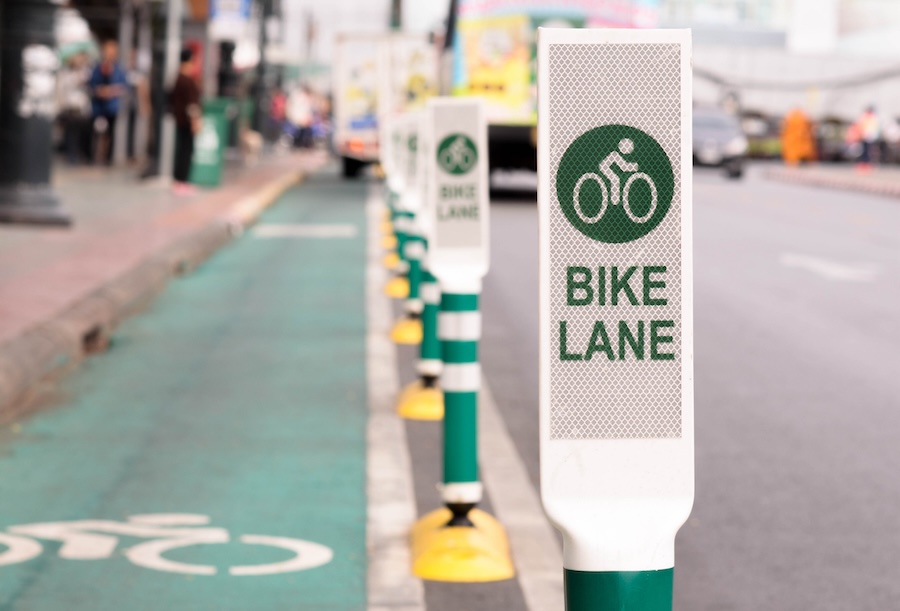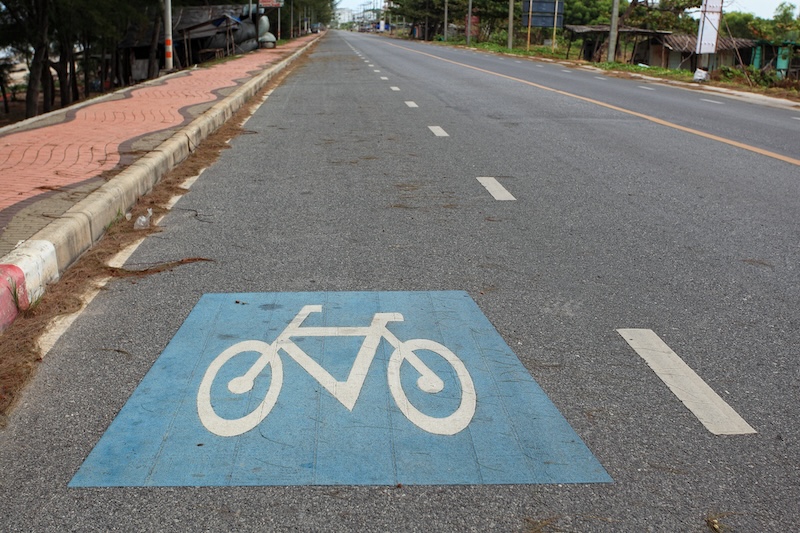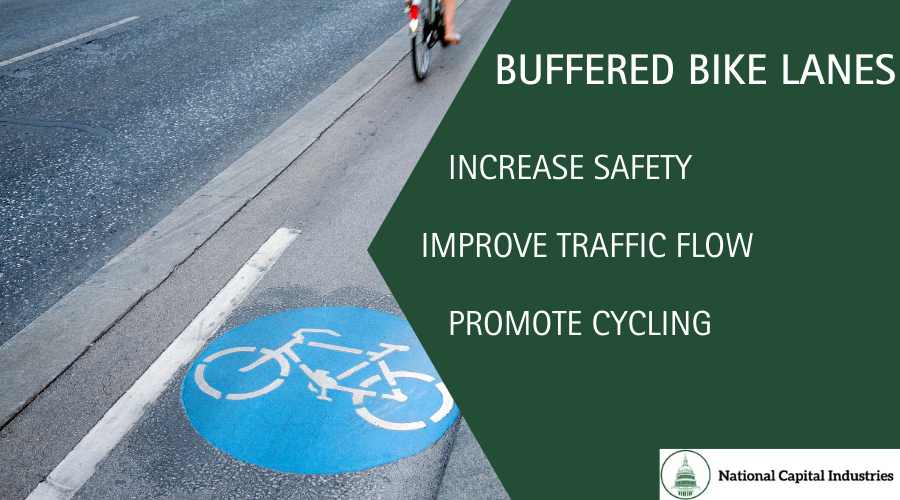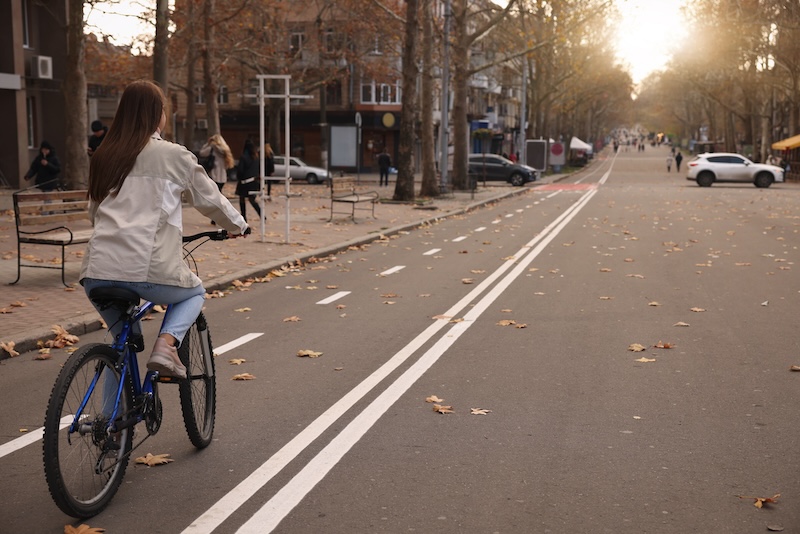
“ A buffered bike lane is a type of bicycle lane designed with additional space that separates the bicycle lane from the adjacent vehicle lane and/or parking lane. These lanes provide a designated buffer space, which could either be a physical barrier, such as flexible posts, or painted lane markings, that creates a safe distance between cyclists and motor vehicle traffic.”
If you’ve been wondering what a buffered bike lane is and why it’s becoming more popular in urban regions, you’re in the right place. Recognizing the value these lanes offer to both cyclists and motorists is crucial for cities, residents, and bicyclists to appreciate their potential and advocate for more of them to be implemented.
It’s important to understand the details of the design elements of buffered bike lanes, their importance in the current transportation scene, and how particular construction products play a crucial role in their development.

Buffered bike lanes differ from standard bike lanes because they provide an extra level of security by providing a greater separation from car doors and moving vehicle traffic, resulting in more comfort for the bicyclist.
Buffered bike lanes, conventional bike lanes, and cycle tracks all contribute significantly to the safety and infrastructure of a community. However, each serves a distinct purpose and caters to specific needs:
A buffered bike lane takes the safety of bicycle lanes a step further. It includes designated buffer space, placed either between the bicycle lane and the adjacent motor vehicle travel lane or between the bicycle lane and the street parking lane, depending on the specific design of the road. The buffer can take several forms – from simple lane markings to flexible posts.
In areas with on-street parking, the buffer can help keep cyclists out of the “door zone,” where parked car doors can open unexpectedly. However, the buffered bike lane’s effectiveness is highly dependent on its specific design elements such as the buffer size and the type of physical separation used. Accurate bike lane width is also crucial for efficient operation.

Buffered bike lanes are much more than designated biking spaces; they provide a host of advantages that support the well-being of both road users and the community at large. Here’s why these lanes are integral to our rapidly changing commuting landscape:
Safety is the main reason for constructing a buffered bike lane. Conventional bicycle lanes offer protection by providing dedicated space for bicyclists. However, the proximity to vehicles in the travel lane and parked cars can still pose risks. With the introduction of a buffer, any surrounding vehicle traffic, including parked cars and their door zones, is further distanced from the bicycle traffic.
Buffered bike lanes make biking more appealing by increasing bicyclist comfort and perceived safety. This encourages more people to shift from cars to bikes, thus reducing traffic congestion, and environmental pollution while improving public health. In cities with lots of traffic, encouraging cyclists to bike to their destinations can help clear out some road congestion.
By allocating distinct and safe areas for different road users, buffered bike lanes recognize bicyclists as legitimate road users deserving of their own space.
Buffered lanes come in various degrees of protection. The additional space can be simply striping or featuring flexible posts or other physical barriers. The buffer space can also be marked with paint between the parking lane and bike lane, thus creating parking-protected bike lanes, further protecting cyclists from car door openings and motor vehicle traffic.
Buffered bike lanes offer cities a cost-effective solution for addressing transportation issues and contribute to creating a vibrant and active urban environment for all residents.
New York City has been at the forefront of implementing buffered bike lanes as part of its ambitious Vision Zero initiative, which aims to eliminate traffic deaths and serious injuries. The city has recognized the importance of creating safer and more accessible cycling infrastructure to encourage more residents to choose biking as a mode of transportation. The first 4 years after the adoption of Vision Zero was the safest 4-year period for traffic collisions in New York City’s history. Since the start of the initiative, New York City has:

The effectiveness of a buffered bike lane is largely dependent on its construction. The use of quality construction products plays a vital role in ensuring these lanes provide maximum safety and fulfill their purpose.
Pavement markings are a fundamental part of the construction process. These markings are essential for defining the bike lane, and the buffer zone, and for guiding both vehicle and bicycle traffic. Quality paint that will last is key here. We recommend the following products for optimal safety:
In the construction of buffered bike lanes, physical barriers, or delineators, are sometimes implemented to provide a higher sense of security for cyclists. From barricades to flexible posts, these barriers help shield cyclists from vehicle traffic and indicate boundaries that motorists need to observe. Consider the following products for high-quality protection:
Reflective, large, and bright traffic signs are important in constructing a safe bike lane. View our extensive collection of signs, or create your own using our custom sign calculator.
The line between a safe and unsafe buffer zone quite literally comes down to the quality of construction products used. Choosing reliable, high-quality equipment and materials is essential to creating successful buffered bike lanes that genuinely protect cyclists and enhance road safety. Ideal products like those offered by National Capital Industries deliver durability, visibility, and ease of installation and maintenance.
When constructing a buffered bike lane, high-quality, reliable products play a crucial role in ensuring success. It’s not just about higher longevity, durability, or visibility, but also includes installer safety, user comfort, and overall public safety. Having a trusted partner to provide those necessary, compliant materials can make all the difference.
NatCap has built a reputation based on our extensive knowledge and experience in supplying contractors with everything they need, from safety equipment to construction materials. As the authorized supplier of significant products like the Crown Pavement markings and Pexco delineators, we are instrumental in setting up reliable buffered bicycle lanes. These products are essential components of the set-up, whether you need to make robust lane markings or create a physical separation between the bike lane and motor traffic or parking.
Whether you are part of a city planning team, a construction project manager, or just interested in improving road safety, understanding the value of buffered bike lanes is the first step. Choose to partner with NatCap and take the next step towards making our roads safer, one bike lane at a time.
Contact us with any questions!
https://www.nyc.gov/html/dot/html/bicyclists/cyclinginthecity.shtml
https://www.nyc.gov/content/visionzero/pages/safe-cycling
https://highways.dot.gov/safety/zero-deaths/vision-zero-new-york-city